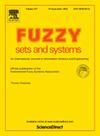Linear programming problem subject to bipolar max-product fuzzy relation equations with product negation
IF 2.7
1区 数学
Q2 COMPUTER SCIENCE, THEORY & METHODS
引用次数: 0
Abstract
In this paper, we study the linear optimization problem with bipolar max-product fuzzy relation equations and product negation. First, we investigate the structure of the solution set for its feasible domain and specify the complete solution set without explicit computation of all of its maximal and minimal solutions under a sufficient condition. In a general case, the complete solution set cannot be completely determined by a finite number of pairs of minimal and maximal solution. Hence, lower and upper bound vectors are presented for its solution set. Some sufficient conditions are also proposed to reduce the dimensions of its feasible domain. We show that each binding variable from a feasible vector can be expressed in terms of the corresponding component of the lower or upper bound vectors. Some sufficient conditions are proposed so an optimal solution for the problem exists such that each of its components is the component corresponding to the lower and upper bound vectors. A value matrix is created based on the characteristic matrix, coefficients of the objective function, and recent property. Some rules are presented to reduce the dimensions of the matrix. A modified branch-and-bound algorithm is then applied to the matrix to find the optimal solution of the problem without detecting the complete solution set of its feasible domain and comparing them. The algorithm decreases the computational complexity considerably compared with the existing algorithms for solving the problem.
具有乘积否定的双极极大积模糊关系方程的线性规划问题
本文研究了具有双极极大积模糊关系方程和乘积否定的线性优化问题。首先,我们研究了其可行域的解集结构,并在一个充分条件下给出了不需要显式计算其所有极大解和最小解的完全解集。在一般情况下,完全解集不能完全由有限数量的最大和最小解对确定。因此,给出了其解集的下界和上界向量。给出了降低其可行域维数的几个充分条件。我们证明了可行向量的每个绑定变量都可以用下界或上界向量的相应分量来表示。给出了该问题存在一个最优解的充分条件,使得它的每一个分量都是下界和上界向量对应的分量。基于特征矩阵、目标函数的系数和最近的属性,创建一个值矩阵。给出了矩阵降维的一些规则。然后将改进的分支定界算法应用于矩阵,在不检测问题可行域的完全解集并进行比较的情况下找到问题的最优解。与现有的求解该问题的算法相比,该算法大大降低了计算复杂度。
本文章由计算机程序翻译,如有差异,请以英文原文为准。
求助全文
约1分钟内获得全文
求助全文
来源期刊

Fuzzy Sets and Systems
数学-计算机:理论方法
CiteScore
6.50
自引率
17.90%
发文量
321
审稿时长
6.1 months
期刊介绍:
Since its launching in 1978, the journal Fuzzy Sets and Systems has been devoted to the international advancement of the theory and application of fuzzy sets and systems. The theory of fuzzy sets now encompasses a well organized corpus of basic notions including (and not restricted to) aggregation operations, a generalized theory of relations, specific measures of information content, a calculus of fuzzy numbers. Fuzzy sets are also the cornerstone of a non-additive uncertainty theory, namely possibility theory, and of a versatile tool for both linguistic and numerical modeling: fuzzy rule-based systems. Numerous works now combine fuzzy concepts with other scientific disciplines as well as modern technologies.
In mathematics fuzzy sets have triggered new research topics in connection with category theory, topology, algebra, analysis. Fuzzy sets are also part of a recent trend in the study of generalized measures and integrals, and are combined with statistical methods. Furthermore, fuzzy sets have strong logical underpinnings in the tradition of many-valued logics.
 求助内容:
求助内容: 应助结果提醒方式:
应助结果提醒方式:


